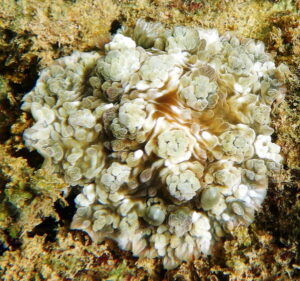
December 7, 2022
Once again, a reef animal made me happy to be alive. While recently snorkeling between days of big surf, I found a nudibranch new to me. I took pictures of the exquisite creature, thanked it for showing itself to me, and then replaced the animal in its patch. My swim home was exciting, and not just because of the current. Searching my books for a marine animal I don’t know is my idea of a good time.
The word nudibranch, pronounced NOODIE-brank, (hard K) is the scientific name for a sea slug, a snail without a shell. Nudies are often so brightly colored and so frilly in design that they are sometimes called butterflies of the sea or orchids of the ocean. Some nudies have colorful common names, such as the Spanish dancer and the jolly green giant.
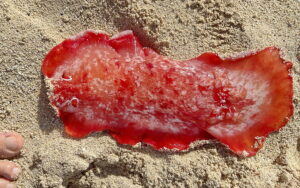
Spanish dancers, common in Hawaii, can grow to 12-inches long (my toes at left for scale), and swim by flexing their soft bodies. Waves beached this one but when we returned it to the water, it swam away in a graceful dance. ©Susan Scott
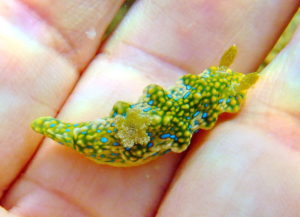
Despite its name, this rare jolly green giant nudibranch grows only 1.5 inches. I found this tiny one (shown on my middle finger) in 2 feet of water on a Waialua reef. ©Susan Scott
Most nudibranchs have no common names, and are known only by hard-to-pronounce, easy-to-forget scientific names. In his outstanding Hawaii guide books, John Hoover uses versions of Latin or Greek species names to assign common names to fish and invertebrates lacking them. And that’s how my beautiful blossom-of-a-nudie got such an inelegant name, the tuberculous nudibranch.
The creature’s scientific name, Dendrodoris tuberculosa, has stood since 1832 when the two French naturalists, Quoy and Gaimaird, called it that. The name tuberculosa made sense because in Latin tuber means a little knob or swelling, a reference to the creature’s bumpy back. In botany, tubers are potatoes and corms. It wasn’t until 1860 that doctors renamed the disease known as consumption tuberculosis after discovering small knobs in the lungs of people who died of it.
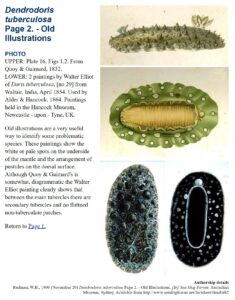
Illustrations from seaslugforum.net
Like me, John Hoover also appreciates the beauty of this nudie. In Hawaiʻi’s Sea Creatures, he writes, “This amazing slug resembles a lady’s flower hat of the last century.” Indeed it does, complete with polka dots under its brim. The species also comes in shades of pink.
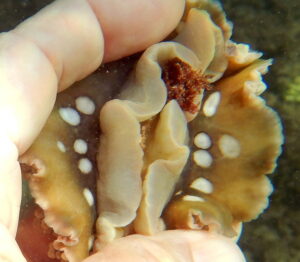
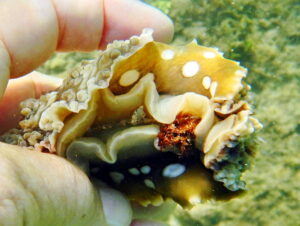
The word nudibranch means naked gills, a name referring to exposed gills on the rear of most species’ backs. Up front, most nudibranchs also have a pair of sensory organs, or tentacles, that look like antennae, or sometimes like eyes. The organs guide the nudie to animal food, such as sponges and corals. All nudibranchs are carnivores.
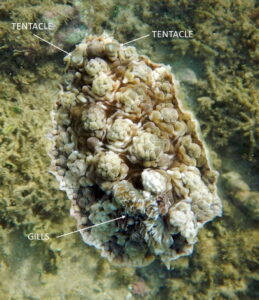
The tentacles and gills of my nudie blended well with its “blossoms” but are clear in this photo. My sea slug was about 4 inches long. They grow to 6 inches and are found throughout the Pacific and Indian Oceans. © Susan Scott
Like all snails, nudies get around by walking on a muscular foot that can cling to whatever the creature encounters, such as my thumb during this photo session.
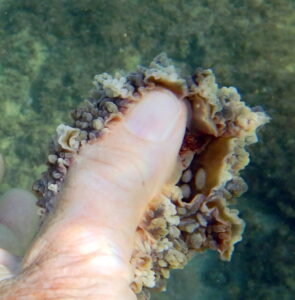
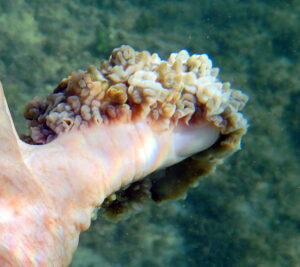
Even though the nudie I found has a name associated with a serious illness, that won’t stop me from marveling over its beauty. I admit, though, that it pains me to call it a tuberculous nudibranch. And so, because I agree with John Hoover’s observation that the creature’s knobs look like flowers, and those flowers remind me of my grandmother’s favorite blooms, for me this amazing animal will be the peony nudie.
Thank you, John Hoover, for your excellent books and helpful names. And thank you, peony nudie, for showing up just as I was passing by.